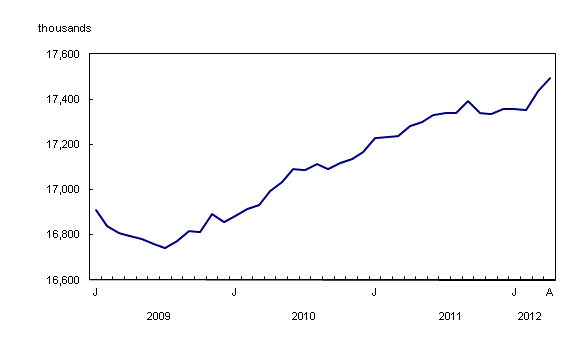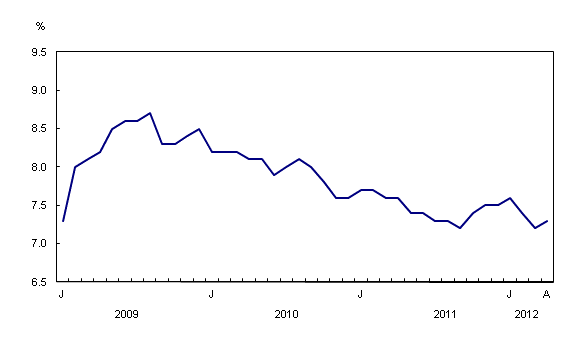Labour Force Survey, April 2012
Archived Content
Information identified as archived is provided for reference, research or recordkeeping purposes. It is not subject to the Government of Canada Web Standards and has not been altered or updated since it was archived. Please "contact us" to request a format other than those available.
Related subjects
-
[an error occurred while processing this directive]
Employment increased by 58,000 in April, mostly in full-time work. This was the second consecutive month of notable gains after four months of little change. With more people searching for work, the unemployment rate increased by 0.1 percentage points to 7.3%.
Compared with 12 months earlier, employment was up 1.2% or 214,000. All of the growth over the 12 months was in full-time work, up 217,000 (+1.6%), while part-time employment was unchanged. The total number of hours worked rose 1.5% over the same period.
Employment

The employment gain in April was primarily in the goods sector, with increases in construction, manufacturing, natural resources and agriculture. Among service industries, education employment increased, while public administration declined.
Employment increased in Quebec, British Columbia, Alberta, Saskatchewan, New Brunswick, Newfoundland and Labrador, and Prince Edward Island. There was little change in the other three provinces.
In April, employment rose among people aged 25 to 54 and those aged 55 and over, while there was little change among youths.
Employment increased in April only among private sector employees. Compared with 12 months earlier, the number of private sector employees was up 2.3%, while public sector and self-employment were little changed.
Unemployment rate

Chart description: Unemployment rate
Employment up in goods-producing industries
In April, construction employment was up 25,000. Compared with 12 months earlier, employment in this industry rose 3.5%, with notable growth since January.
Employment in manufacturing increased 24,000 in April, continuing an upward trend that started in December 2011. These recent gains offset declines in previous months, leaving employment in manufacturing little changed from 12 months earlier.
There was an employment gain of 17,000 in educational services. Education employment in April 2012 was similar to that of 12 months earlier.
Natural resources employment continued on an upward trend that started in September 2011, with gains of 11,000 in April. This industry remained the fastest growing of all industries, posting year-over-year employment growth of 12.5%.
Agriculture employment increased by 10,000 in April. Employment in this industry was little changed over the past two years.
Following little change from April 2011 to March 2012, employment in public administration declined by 32,000 in April.
Gains in most provinces
In Quebec, employment increased for the second consecutive month, up 23,000 in April, and the unemployment rate was 8.0%. Compared with 12 months earlier, employment in the province was little changed.
Continuing an upward trend that began in February 2011, employment in British Columbia increased by 20,000 in April. Compared with 12 months earlier, employment growth was 2.1%, the third-highest of all provinces. Since the unemployment rate peaked at 8.7% in February 2011, it has gradually declined to 6.2% in April.
Following four months of little change, employment in Alberta increased by 11,000 in April, and the unemployment rate declined 0.4 percentage points to 4.9%. Employment in the province increased 3.9% over the previous 12 months, the fastest growth of all provinces.
Employment in Saskatchewan increased by 6,800 in April, following three months of little change. Compared with 12 months earlier, employment grew 2.3%, the second-highest growth rate among the provinces.
Employment increased by 4,500 in New Brunswick, but was little changed from 12 months earlier.
Employment also increased in Newfoundland and Labrador, up 3,900 in April. Employment has been on an upward trend since October 2011, after declining over the previous five months, leaving the number of employed in the province unchanged over the 12-month period.
Employment in Ontario was little changed in April, but with more people searching for work, the unemployment rate increased 0.4 percentage points to 7.8%. While employment was up compared with 12 months earlier, it was entirely the result of notable gains in March.
Employment up among people aged 25 and over
Following five months of little change, employment increased by 33,000 among people aged 25 to 54. Compared with 12 months earlier, employment for this age group was up 0.5%, with gains among both men and women.
Employment among those aged 55 and over continued on an upward trend, up 26,000 in April. Compared with 12 months earlier, employment among men and women of this age group increased 5.5%, partly the result of population aging.
Following a gain in March, employment for youths in April was little changed, and their unemployment rate remained at 13.9%. Youth employment has been little changed since July 2009.
Canada–United States comparison
The number of employed as a percentage of the working-age population in Canada, that is the employment rate—when adjusted to U.S. concepts—was markedly lower than that of the United States from the early 1990s until 2002. Since 2002, the adjusted employment rate in Canada has been higher, with the gap between the two countries widening since late 2006.
In April, the employment rate was 62.6% in Canada when adjusted to U.S. concepts. This was 4.2 percentage points higher than the comparable rate of 58.4% in the United States. The gap in the employment rates between the two countries has been around 4 percentage points since June 2010.
From the early 1980s until 2008, the adjusted Canadian unemployment rate was higher than the rate in the United States. However, since that time, the Canadian rate has been lower, with a gap of around 2.5 percentage points since late 2009.
In April, the adjusted unemployment rate in Canada was 6.4%, compared with 8.1% in the United States, for a gap of 1.7 percentage points. The gap has narrowed slightly in recent months, mainly as a result of a decline in the number of people actively searching for work in the United States.
Note to readers
The Labour Force Survey (LFS) estimates are based on a sample, and are therefore subject to sampling variability. Estimates for smaller geographic areas or industries will have more variability. For an explanation of sampling variability of estimates, and how to use standard errors to assess this variability, consult the "Data quality" section of the publication Labour Force Information (Catalogue number71-001-X, free).
Unless otherwise stated, this release presents seasonally adjusted data, which facilitates comparisons by removing the effects of seasonal variations. For more information on seasonal adjustment, see Seasonal adjustment and identifying economic trends.
Available without charge in CANSIM: tables CANSIM table282-0001 to 282-0042, CANSIM table282-0047 to 282-0063, CANSIM table282-0069 to 282-0095 and CANSIM table282-0100 to 282-0121.
Definitions, data sources and methods: survey number survey number3701.
A more detailed summary, Labour Force Information (Catalogue number71-001-X, free), is now available online for the week ending April 21. From the Key resource module of our website under Publications, choose All subjects, then Labour.
Data tables are also now available online. From the Subject module of our website, choose Labour.
The next release of the Labour Force Survey will be on June 8.
For more information, contact Statistics Canada's National Contact Centre (toll-free 1-800-263-1136; 613-951-8116; infostats@statcan.gc.ca).
To enquire about the concepts, methods or data quality of this release, contact Jason Gilmore (613-951-7118; jason.gilmore@statcan.gc.ca) or Vincent Ferrao (613-951-4750; vincent.ferrao@statcan.gc.ca), Labour Statistics Division.
- Date modified:
